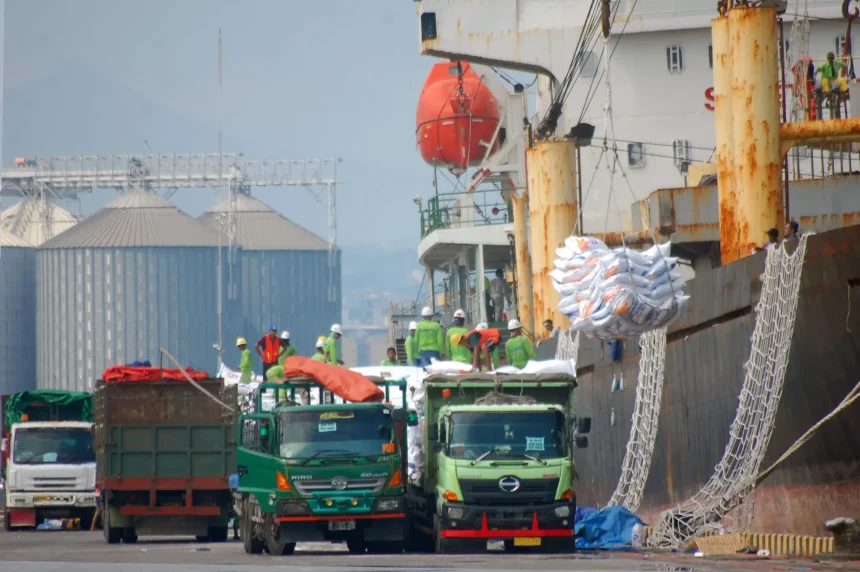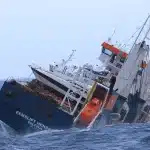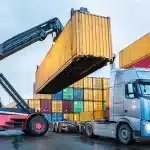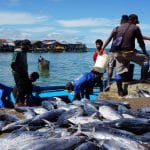Liga Asuransi – Dear risk takers, risk managers, underwriters, carriers, farmers, traders and readers, Welcome to Insurance League, the premier source of information on risk management and insurance. As a senior insurance broker with a special focus on the unique challenges of the grain transportation sector, I am thrilled to discuss the ins and outs of this important industry.
In this article, we will explore the risks associated with transporting rice and the important insurance solutions to protect your shipments. Our goal is to equip you with the knowledge necessary to make informed decisions and ensure smooth handling of your cargo.
If you found this article useful, please share it with your network so they too can benefit from these insights. Thank you for joining us on this journey to improve your risk management understanding and practices.
Rice is a staple food in Indonesia, crucial to the country’s diet, culture and economy. As one of the largest producers and consumers of rice in the world, Indonesia relies heavily on rice for food security and economic stability. The country’s diverse climate and fertile soil favor the cultivation of various varieties of rice, making it a crucial agricultural sector.
Rice farming is mostly carried out by small farmers who grow rice in rice fields scattered in rural areas. The main rice producing regions include Java, Bali and Sumatra, which benefit from favorable conditions for rice cultivation that rely on both rain and irrigation. The Indonesian government supports the rice sector through policies and programs aimed at increasing productivity, improving infrastructure and ensuring food security.
Transporting rice from farm to market involves complex logistics due to the perishable nature of rice and the vast Indonesian archipelago. Efficient transportation is very important to maintain rice quality and meet domestic and export demand. Despite progress, challenges such as limited infrastructure, seasonal weather conditions, and logistical inefficiencies still exist. Addressing this issue is critical to maintaining the rice supply chain in Indonesia and ensuring stable food availability for its population.
The Importance of Transporting Rice in Indonesia
Transporting rice in Indonesia is critical to ensuring food security and economic stability. As the country’s staple food, rice needs to be moved efficiently from farms in rural areas to markets and distribution centers in urban areas. Effective transportation supports timely delivery of fresh rice, prevents spoilage, and maintains quality.
In the geographically diverse Indonesian archipelago, where many areas are isolated, reliable transport links are crucial. This network connects rice producing regions with areas of high demand, ensuring a stable supply across the country. Additionally, efficient transportation helps stabilize prices by reducing the risk of shortages and oversupply.
Furthermore, the transportation of rice affects the overall efficiency of the agricultural supply chain, impacting both local and international markets. Appropriate logistics support not only meets domestic consumption needs but also increases Indonesia’s export potential, contributing to the country’s economic growth and development.
Types of Rice Transported
In Indonesia, various types of rice are transported to meet diverse consumer needs:
White Rice
The most commonly consumed type, white rice is polished and processed to remove the husk, bran, and germ. It is a staple food for most Indonesians and is widespread throughout the country.
Brown rice
Less processed than white rice, brown rice retains its bran and germ, offering higher nutritional value. It is often transported to health-conscious consumers and niche markets.
Fragrant Rice
Known for its aromatic qualities, this rice includes varieties such as jasmine and pandan. It is loved for its distinctive smell and taste.
Glutinous rice
Also known as sticky rice, this type is used in a variety of traditional dishes and desserts. It is popular in areas with a strong culinary tradition of sticky rice-based foods.
Red and Black Rice
This type of rice is less common but is prized for its nutritional benefits and unique taste. They are often marketed as specialty or organic products.
Each type requires special handling and transportation methods to maintain quality and meet consumer demand.
Common Modes of Rice Transportation
Transporting rice in Indonesia involves a variety of modes, each suited to different logistics and geographic needs:
Truck
Trucks are the main mode for transporting rice over short to medium distances. They provide flexibility and are essential for shipping rice from mills to local markets, retailers, and distribution centers. Trucks are especially useful for accessing rural areas and smaller distribution points.
Train
For mass transportation over longer distances, rail transportation is often used. Trains can transport large quantities of rice efficiently from major rice producing areas to city centers and port facilities. Railways are cost-effective for high volume shipments.
Boat
In Indonesia, with its vast archipelago, shipping plays an important role. Cargo ships and barges transport rice between islands, connecting rice-producing regions with consumer markets throughout the country. This method is very important for distributing rice to remote or isolated areas.
Air Freight
For urgent shipments or special rice varieties, air freight is used, although less frequently due to higher costs. This ensures timely delivery to remote or remote locations.
Each mode has its own advantages and is selected based on factors such as distance, volume and urgency.
Key Stakeholders in Rice Transportation
Key stakeholders in rice transportation in Indonesia include:
Farmer
They are the primary producers of rice, responsible for growing and harvesting the crop. Their output drives the transportation process.
Rice Milling Factory
Rice mills process harvested rice into rice ready to be marketed. They are at the center of the supply chain, preparing rice for distribution.
Transportation Company
These companies handle the logistics of moving rice from factories to distribution centers, retailers and export points. They operate trucks, trains, ships, and other modes of transportation.
Distributor
They manage the distribution of rice to wholesalers, retailers and markets, ensuring that rice reaches various points of sale.
Retailer
Local shops, supermarkets and markets sell rice to consumers. They are the final link in the distribution chain.
Regulatory Body
Government agencies enforce quality standards and regulations for the transportation of rice, ensuring food safety and compliance.
Potential Risks in Rice Transportation
Transporting rice in Indonesia involves several potential risks that can impact safety, quality and efficiency:
Rot and Contamination
Rice is susceptible to spoilage due to moisture, pests and contaminants. Inadequate storage or transportation conditions may result in mold, insect infestation and loss of quality.
Theft and Vandalism
Rice is a valuable commodity, making it vulnerable to theft and vandalism during transit. Safe handling and transportation measures are necessary to prevent loss.
Accidents and Damage
Transportation accidents, such as collisions or vehicle accidents, can cause damage to rice packaging or damage the product. Proper packaging and handling are essential to reduce these risks.
Compliance with Regulations
Failure to comply with food safety regulations and standards may result in legal penalties and product recall. Ensuring compliance with these regulations is critical.
Weather and Natural Disasters
Adverse weather conditions, such as heavy rain or flooding, can disrupt transportation routes, causing delays and potential damage to rice.
Logistical Challenges
Inadequate logistics infrastructure or planning can lead to delays, inefficient distribution and increased costs, affecting timely delivery of rice.
Addressing these risks through effective risk management strategies is critical to ensuring the smooth and reliable transportation of rice.
Risk Management Strategy
An effective risk management strategy for transporting rice in Indonesia is essential to ensure product quality, safety and efficiency. Here is a comprehensive approach to reducing risk:
Quality Control and Inspection
Implement strict quality control measures at every stage of the transportation process. Regular inspection of rice before and after loading, as well as during transit, can identify and address potential problems such as contamination or spoilage early.
Proper Packaging and Handling
Use high-quality, moisture-resistant packaging to protect rice from environmental factors and physical damage. Ensure rice is handled carefully to prevent spillage, damage or contamination during loading and unloading.
Safe Transportation
Use a vehicle that is safe and well maintained. Check and maintain vehicles regularly to prevent damage and accidents. Use a GPS tracking system to monitor transportation routes and ensure on-time delivery.
Insurance
Get comprehensive insurance coverage for rice during transportation. This includes coverage for damage, spoilage, theft, and other potential losses. Work with an experienced insurance broker to tailor coverage to specific needs and risks.
Compliance with Regulations
Ensure compliance with all relevant food safety and transportation regulations. Keep local and international standards up to date to avoid legal issues and ensure that rice meets all quality and safety requirements.
Emergency Response Planning
Develop and implement emergency response plans for potential incidents, such as accidents or natural disasters. This plan should include damage control procedures, communication with stakeholders, and recovery.
Training and Awareness
Provide training for personnel involved in the transportation process to ensure they are aware of best practices, safety protocols and risk mitigation strategies.
By adopting this strategy, stakeholders can manage risks effectively and ensure safe and efficient rice transportation throughout Indonesia.
Insurance Solutions for Rice Transportation
Insurance solutions for rice transportation are essential to protect against various risks that can affect the quality, safety and financial stability of the supply chain. Here is a comprehensive approach to insurance coverage:
This is the main coverage for rice during transportation. This protects against loss or damage caused by accidents, theft, or natural disasters. Make sure that the policy covers all modes of transport (road, rail, sea) and includes provisions for damage due to rot or contamination.
For shipments involving sea transportation, marine insurance is essential. It covers risks associated with maritime transit, including maritime hazards, piracy and cargo damage. It also addresses risks during loading and unloading operations.
Transit Insurance
This policy covers the risk of damage or loss of rice while in transit. This usually includes coverage for events such as accidents, fire, and natural disasters. Ensure coverage extends across the entire transportation route, from the point of origin to the final destination.
Warehouse Insurance
Rice often needs to be stored before and after transportation. Warehouse insurance covers risks associated with storage, such as fire, theft, and damage due to mishandling or environmental conditions.
Contingent Cargo Insurance
This type of coverage is useful if primary insurance is inadequate or if there are gaps in coverage. This provides additional protection and ensures that risks not covered by other policies are addressed.
Liability Insurance
This covers the transport operator’s responsibility for damage caused during the handling or transport of rice. This protects against claims related to accidents, environmental damage, or other liabilities.
Customs and Import/Export Insurance
For international shipments, ensure coverage covers customs-related risks, such as delays or fines due to documentation or regulatory compliance issues.
By choosing the right insurance solution, stakeholders can mitigate financial risks and ensure that rice transportation is safe, efficient and protected from unexpected events. Engaging with a knowledgeable insurance broker can help customize coverage to meet the specific needs and risks associated with rice transportation.
Role of Insurance Broker
Insurance brokers play an important role in managing the risks associated with rice transportation by acting as intermediaries between clients and insurance providers. They assess the specific needs and risks of the transportation process, such as potential damage or loss during transit, and recommend appropriate insurance solutions.
Brokers leverage their expertise to find the best policies that offer comprehensive coverage at competitive rates. They also assist in negotiating terms and conditions to ensure that policies are tailored to the unique aspects of rice transportation. Additionally, brokers assist with claims management, guiding clients through the process of filing and resolving claims efficiently. Their role ensures that clients receive optimal coverage, effective risk management, and support during unexpected events, ultimately protecting the transport of valuable cargo and maintaining business continuity.
MWhy did you choose L&G Insurance broker for marine cargo insurance?
Choose L&G Insurance Broker Marine cargo insurance in Indonesia offers several distinct advantages:
Expertise in Marine Insurance
L&G Insurance Brokers has extensive experience in marine cargo insurance, understanding the unique risks associated with transporting goods by sea, including the potential for damage, loss and delay.
Customized Solutions
We provide customized insurance solutions that meet your specific cargo needs, ensuring you receive the most appropriate coverage for your ocean shipments.
Local Knowledge
With a deep understanding of Indonesian maritime and logistics regulations, L&G Insurance Brokers is well equipped to navigate local challenges and provide relevant advice.
Strong Industrial Linkages
Our established connections with leading insurance providers allow us to offer competitive rates and favorable terms, ensuring you get the best value for your insurance premiums.
Comprehensive Coverage
We offer a variety of coverage options that protect against a variety of risks, including damage from natural disasters, piracy and mishandling, giving you peace of mind during transit.
Efficient Claims Handling
In the event of a claim, our experienced team provides prompt support and guidance to streamline the process, minimize delays and maximize recovery.
Choosing L&G Insurance Broker means partnering with a trusted advisor dedicated to protecting your marine cargo and supporting your business success.
Looking for insurance products? Don’t waste your time and contact us now
HOTLINE L&G 24 JAM: 0811-8507-773 (CALL – WHATSAPP – SMS)
Website: lngrisk.co.id
Email: oktoyar.meli@lngrisk.co.id
—
















